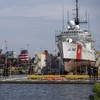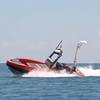Neptune Deepwater LNG Port Application Complete
"Our team has committed countless hours to ensure that Neptune will live up to the highest environmental, safety, and reliability standards," said Rick Grant, President and CEO of SUEZ LNG NA. "As a member of the Massachusetts business community for 35 years, our company has carefully planned each aspect of Neptune, from location to ship design. We believe operating both this deepwater port and our onshore LNG import terminal in Everett, Massachusetts, will go a long way toward meeting New England's increasing demand for natural gas while continuing to provide highly reliable service."
Demand for natural gas from power generators and residential consumers in New England is expected to increase by 1-2 percent per year over the next two decades, with Massachusetts alone accounting for half of the region's natural gas consumption. At this rate of growth, the region could face a supply gap approaching 500 million cubic feet per day in five years.
Neptune will provide an average of 400 million cubic feet of natural gas per day -- enough to serve 1.5 million homes daily. On very cold days and other periods of peak demand, each Neptune vessel can increase its delivery rate to 700 million cubic feet of natural gas per day. Thus, by increasing supply to the region, the project will help ensure that homes in Massachusetts and the rest of New England have heat when temperatures drop and electricity year round.
Because of Neptune's location off the coast of Massachusetts' North Shore, local consumers also have "first claim" to the natural gas imported through Neptune, just as they do with the Everett Terminal, versus the typical "last claim" of supplies from the Gulf of Mexico or Canada. Further, Neptune would provide critical pipeline pressure support during periods of peak demand.
Neptune Project Overview
The Neptune port will operate by mooring specially designed LNG ships equipped to store, transport, and vaporize LNG into natural gas that can be sent to customers using the existing HubLine(SM) sub-sea pipeline. The LNG carriers will moor at the proposed deepwater port by means of a submerged unloading buoy system consisting of two buoys. An LNG ship will typically moor for four to eight days, depending on market demand. The two separate buoys will ensure that natural gas can be delivered in a continuous flow by having a brief overlap between arriving and departing LNG carriers. Neptune LNG anticipates the project's development phase, including regulatory and public consultation and evaluation, and a formal project application review, to take approximately 15-18 months. The company anticipates construction of the deepwater port components to take an additional 3 years.
Neptune's location has several important benefits. It does not require any precious coastal land, and also limits aesthetic impacts. Additionally, the site offers the necessary water depth to support the buoy system technology while specifically avoiding the Stellwagen Bank National Marine Sanctuary and essential shipping lanes into Boston Harbor.












